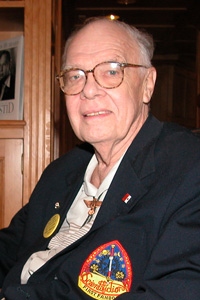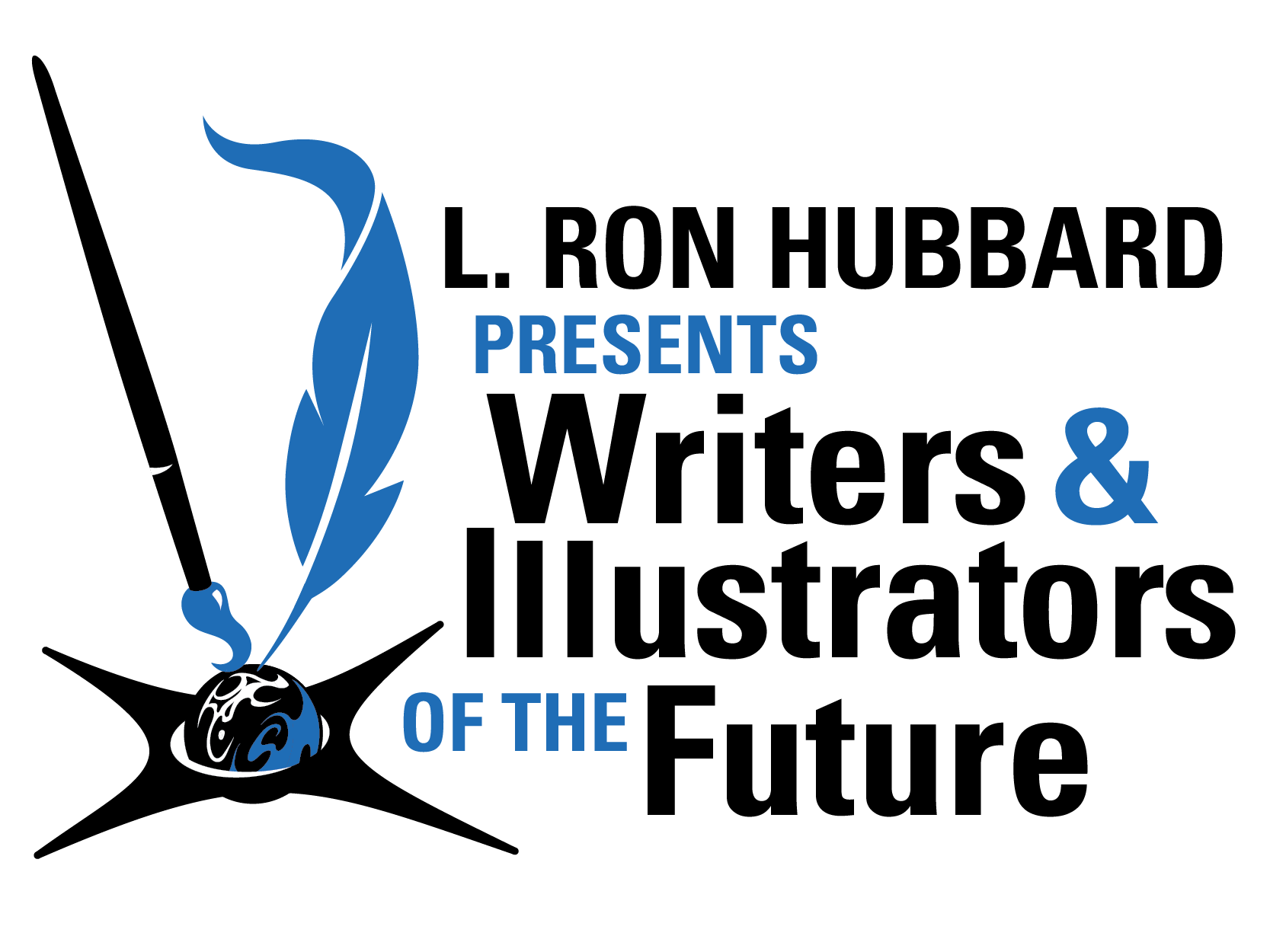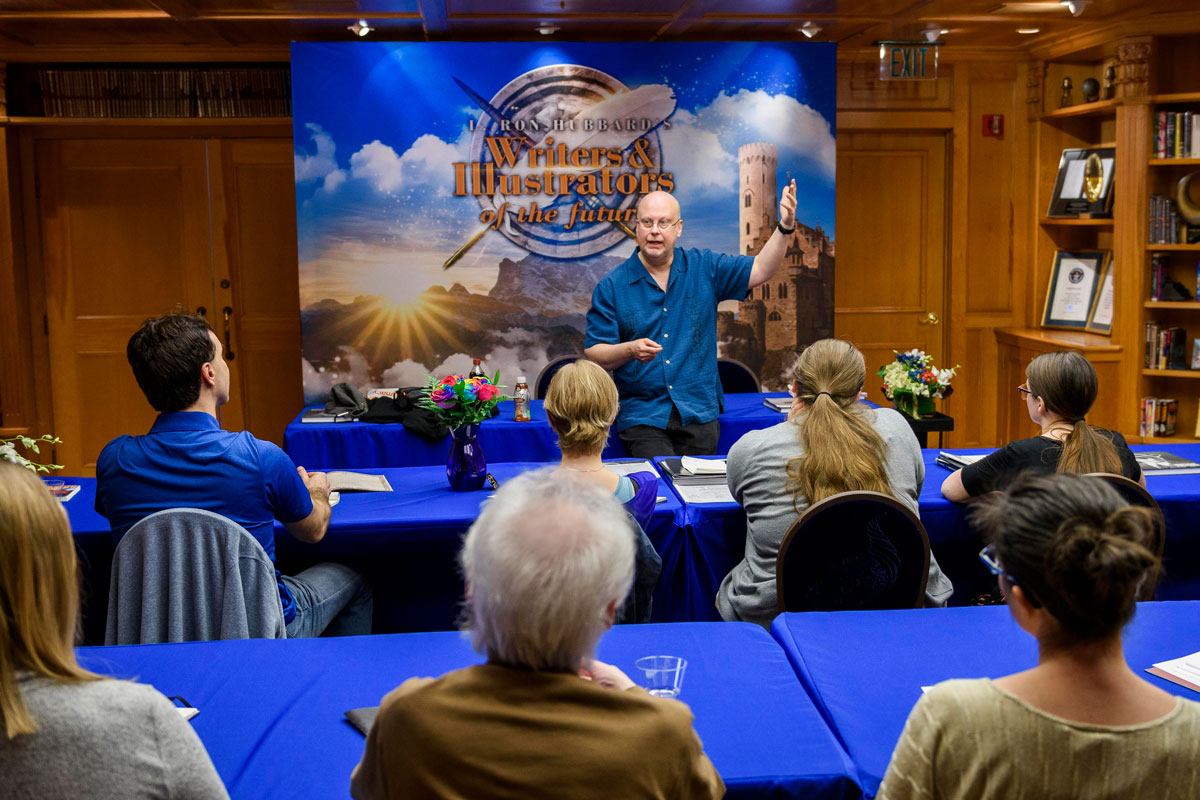The Magic Picture
Here is the next in a series of articles addressing the barriers to achieving your writing goals as requested by you, the new writer. It was also unanimous that you wanted to hear from top-line professionals as to how they overcame these same barriers.
In this article originally written for and published in Writers of the Future Volume 5 in 1989, Hal Clement, member of Science Fiction’s First Fandom and Grand Master of Science Fiction, deals with how to effectively “challenge readers with the ‘what if?’ implications of a background significantly different from the familiar and everyday.”
So if you are interested in learning from a Grand Master, read on …
The Magic Picture
Every story has a background; an environment in which—and a set of rules under which—everything happens, and writer and reader (or teller and listener) must have a reasonably similar idea of the nature of that background for the story to make sense.
In ordinary adventure or romance tales, the familiar “real” world forms the background, and the similarity can be taken for granted. Even in historical novels, while the author must specify the period somehow, it is usually safe to assume that the reader knows a fair amount of relevant history.
In fantasy and science fiction things are very different. The whole point is to challenge readers with the “what if?” implications of a background significantly different from the familiar and every day. A verbal picture has to be painted, and the wordage needed to do the background is what commonly makes SF novels easier to write than shorter fiction. The ordinary storytelling rules of pacing, characterization, and motivation still apply, but the SF writer has additional work to do; book-length offers more freedom to do that.
Why bother with the extra work?
The key reason is consistency; lack of this quality in a story will bother all but the most utterly passive readers. The slips may be minor but still annoying; Ozma’s magic picture, in Frank Baum’s Oz stories, sometimes has a gold frame and sometimes a radium one, and is sometimes called a magic mirror instead. This never has serious effect on the plotline; the existence and properties of the picture itself are the only important things; but to readers who thought they had the background clearly in mind, the changes still give a jolt.
Hard Science Fiction
In the “hard” science fiction which I personally favor, the background is “real” but deliberately unfamiliar in some ways. Here, at least one aim of the writer is to take the reader by surprise with a “what if?” that is logical but unexpected, as with Phileas Fogg’s gain of an extra day by going eastward around the world. The chief professional difficulty lies in spotting all the implications of the unfamiliar insertion, so as to maintain consistency. This task sometimes frightens writers out of the field. In my opinion, it should instead be taken as an opportunity; the implications can provide plot and action ideas. For example:
Quite commonly, science fiction authors have used planets whose atmospheres contain chlorine in place of oxygen. The usual implicit justification is that chlorine is almost as active as oxygen and chlorine-breathing creatures would probably do as well as we oxygen-breathers.
On the whole, I would agree, though as a matter of fact there is a minor energy disadvantage for the chlorine types. However, unless other implications of the chlorine (or fluorine, which has an energy advantage over oxygen) are considered, the author faces a strong risk of consistency slips (embarrassing), and of overlooking potential story-line material (wasteful!).
Some people claim that chlorine atmospheres are unlikely because chlorine is much less common in the universe, and probably on any given planet, than oxygen. True but unimportant; it is not necessary for a substance to be the most common, merely that there be enough of it. If the most common were automatically the most probable, we should be silicon instead of carbon beings ourselves; silicon-based life has been a favorite with writers for decades because of the chemical similarities between the two elements, and they may be right. It may be only chance that we turned out as we did, even though Earth’s crust is about a quarter silicon by mass and well under one percent carbon, but I doubt it (I am not saying that silicon life is impossible; that’s a different and much longer debate).
There is plenty of chlorine on Earth, however. If you want to write a mad-scientist story in which a genetic engineer plans to deploy organisms that can oxidize the chloride ion to the free element, you have a realistic plot. Only about a tenth of the chloride now in Earth’s oceans would have to be processed to match our present oxygen supply with CI2. Conceivably, it was only chance that the photosynthesis that works on oxides such as water evolved before one using chlorides; we might have been chlorine-breathers ourselves (an alternate-universe suggestion I haven’t seen used yet; please note my continuing point of possible storylines). In fact, there were (and still are) bacteria on Earth that used iron, and others that used sulfur in about that way, and which did come first. Why they didn’t end up in charge of Earth is another long question, and of course another possible set of story backgrounds.
If we grant a planet where a chlorine atmosphere does exist, what other implications are there?
Further Assumptions
They depend on further assumptions. If the temperature is in the liquid-water range, for example, we have the fact that chlorine dissolves (rather slowly) in water, reacting with it to give hydrochloric and hypochlorous acids; the latter in turn decomposes slowly to hydrochloric acid and free oxygen. To maintain the chlorine atmosphere, then, we need some process (presumably the original chloride-oxidizing photosynthesis) that will turn the acid back to free chlorine as fast as it forms; and we must also accept the fact that there will be some—possibly small but certainly not zero—concentration of free oxygen as well as the chlorine in the atmosphere.
If we had preferred fluorine, things would have been more difficult (read: more challenging). Fluorine also reacts with water, forming hydrofluoric acid and free oxygen. The acid is viciously active, even on the common silicate minerals of an ordinary Earthlike planet, with which it forms SiF4. This is a gas that is also pretty active, and the long-term result will put the fluorine into insoluble minerals, just where we find it on Earth, instead of into the oceans like chlorine. Maybe some unfortunate early life, far back in Earth’s history, did develop a fluorine-releasing variety of photosynthesis, but couldn’t keep things going. If Earth were enough colder to have hydrogen fluoride oceans, with water a solid mineral, now….
Be my guest again. But do some chemistry of your own; there are other problems (read: story inspirations) to be checked along this line.
With that taken care of, consider the problem of seeing. I don’t, obviously, mean that the eyes of a being that has evolved in a chlorine environment would be irritated by the gas as ours are; but as most people know, chlorine is visibly colored—greenish, hence its Greek-origin name. Scientifically, we say that it absorbs radiation in the visible spectrum, more heavily at the long-wave end. This implies that over more than a short distance, which I haven’t tried to calculate since I haven’t tried to write this story yet, the atmosphere is opaque to human vision. Presumably native organisms, if they have evolved anything comparable to our sense of sight, use a different part of the spectrum.
What part? I don’t know; you’re writing the story. If I did decide to try it myself, I would find out what I could about the absorption spectrum of molecular chlorine—or just possibly, if I were in a real hurry for some reason or got too lazy to finish the research, I would cross my fingers and tell myself that, say, microwave radio photons are too low in energy to affect electronic, spin, or vibrational energies of the CI2 molecule. In the latter case I would not be too surprised, after the story appeared in print, to get a critical letter from a spectroscopist.
I don’t want to scare potential writers into confining themselves to the narrow, “mainstream” part of the storytelling field. I want to show the desirability of considering as many as possible of the possibilities—something we would like to do in engineering and politics as well. However, I grant that spotting them all is just as impossible in this field as in those.
Producing a good story
One can certainly produce a good story that concentrates on one “what-if?” and deliberately ignores others. Rick Raphael‘s “Code Three” dealt with the problems of a highway patrolman in a North America laced with five-mile-wide superhighways, whose speed lanes went above five hundred miles per hour. Many of the cars were jet-driven, and nuclear-powered ones were just starting to appear. I personally doubt strongly the possibility of fueling such a civilian fleet, but I still enjoyed the story—plot, action, motivation, characters, and all—except the end of the book version, which was perfectly logical and reasonable but unhappy (that is, my objection was a subjective, not a professional, criticism).
I realize, and want to emphasize, that Mr. Raphael may have omitted the fuel matter intentionally. He may have felt that discussing it would harm the pace of the story; he may have been saving that question for another story; he may have disagreed with me about the weight of the problem, afterthought and calculation. He could even be right; science is an inherently tentative field, and maybe I didn’t consider enough factors. (Certainty is only an emotion, and science is not for you if you feel a strong need for it. Join a group that depends on faith).
You are, in the final analysis, going to have to use your own judgment in painting your non-standard background picture. You can research in books and journals, pick the brains of friends, get information from computer networks; but only you can decide, for purposes of the story you want to tell, whether we are heading for a Larry Niven world in which checking into a hotel entails the risk of having the bed booby-trapped with high voltage and finding yourself sold for spare parts the next day, or the kind I used in “Mechanic” where the genetic code has been reduced to engineering practice and a patient’s new heart or leg can be grown from a snip of his own flesh, thereby obviating tissue rejection as well as organlegging.
Painting a Word Picture
You are painting a word picture (or a series of them— the frames in a movie). Your pigment is your vocabulary, your brushes are the rules of grammar, and your model is the universe—the known (and thinkable, if you’re extrapolating) laws of Nature.
The desirability of a good vocabulary (a rich palette) is obvious. Skill with brushes (the rules of expression that help avoid ambiguity and other forms of confusion) seems to me equally important. Many people, however, question the need for a model (scientific knowledge).
Personally, I find it convenient to have a lot of the rules and facts in my head, though the last three words are certainly not essential and not always correct—I often have to look things up. It greatly speeds up the process of painting-in the background, and it is also a fertile source of story ideas by itself. It does not, of course, preserve me from error; all of us, every now and then, take something to be so obvious that we don’t need to check it, and then find we were wrong. Just after World War II, I was assuming that jet aircraft would not be practical commercially because of their enormous fuel consumption; I was a bomber pilot, and had a fair supply of relevant knowledge. What I should have been considering, of course, was not pounds of fuel per hour, but ton-miles or passenger-miles per pound of fuel.
 In my novel, Mission of Gravity, I assumed, in spite of my perfectly valid astronomy degree, that my planet Mesklin would have an elliptical polar cross section (it was written before slide-rules grew buttons). Later, the MIT Science Fiction Society had a great deal of fun calculating what the actual shape would be, and of course telling me about it. In the same work, I took it for granted that my leading character’s vessel, the Bree, would sail faster with the wind behind it. A sailor straightened me out on that one. I should have known better; I just didn’t make the high-school-physics vector analysis I should have (and which I wouldn’t have had to make if I’d ever done any sailing; the situation would have been familiar).
In my novel, Mission of Gravity, I assumed, in spite of my perfectly valid astronomy degree, that my planet Mesklin would have an elliptical polar cross section (it was written before slide-rules grew buttons). Later, the MIT Science Fiction Society had a great deal of fun calculating what the actual shape would be, and of course telling me about it. In the same work, I took it for granted that my leading character’s vessel, the Bree, would sail faster with the wind behind it. A sailor straightened me out on that one. I should have known better; I just didn’t make the high-school-physics vector analysis I should have (and which I wouldn’t have had to make if I’d ever done any sailing; the situation would have been familiar).
The word, then, is to spend all the time and effort that you want in working out your hard-science background material. I spend a lot because it’s fun (for me). If you don’t enjoy it, don’t feel guilty; maybe (probably!) you’re a better character builder than I.
Don’t however, expect to avoid all mistakes, and don’t worry when you’re caught. You’re in the entertainment business, and many of your readers will get fun out of catching you. Just remember that the fewer mistakes you do make, the more triumph they’ll feel when they do; don’t make any on purpose.
And don’t try to claim that you did. “Touché” is a courtesy not restricted to fencing.

Harry Clement Stubbs (1922-2003) earned degrees in astronomy, chemistry and education. He was a multi-engine pilot in World War II. By that time he was already capturing the attention of Astounding readers with a kind of SF writing he, in effect, invented and whose leading practitioner he remains. It’s usually called “hard-science fiction”; a combination of a gripping story—as in his famous Mission of Gravity—with meticulously worked-out scientific extrapolation of a totally alien environment, told entirely or in large part from the viewpoint of an intelligent and appealing, but totally alien, inhabitant of that environment … to whom it’s just that ordinary place he lives and must be brave in.
He was named Grand Master by the Science Fiction Writers of America in 1998 and became a Writers of the Future judge in 2001.




Leave a Reply
Want to join the discussion?Feel free to contribute!